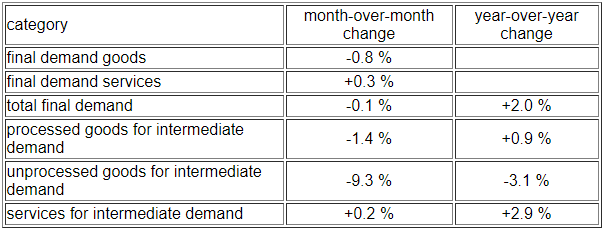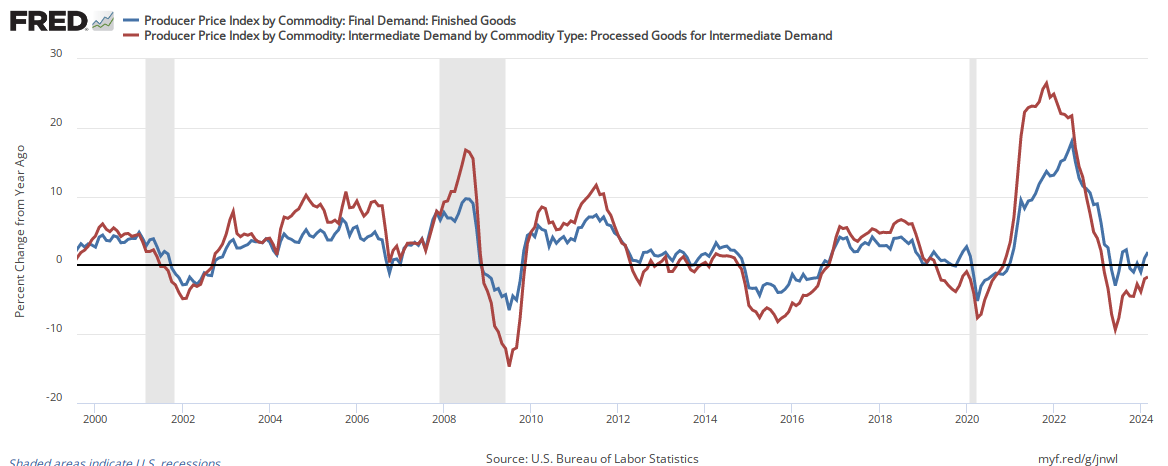January 2019 Producer Price Final Demand Year-Over-Year Inflation Moderated
The Producer Price Index year-over-year inflation moderated from 2.5 % to 2.0 %.

Analyst Opinion of Producer Prices
The Producer Price Index moderated. Energy prices decline was the major reason for the decline. Here is what the BLS said in part:
Final demand goods: The index for final demand goods fell 0.8 percent in January, the largest decrease since dropping 1.2 percent in September 2015. Over three-quarters of the January decline can be traced to prices for final demand energy, which moved down 3.8 percent. The index for final demand foods fell 1.7 percent. Conversely, prices for final demand goods less foods and energy climbed 0.3 percent.
Product detail: Forty percent of the decrease in the index for final demand goods is attributable to a 7.3- percent decline in gasoline prices. The indexes for fresh and dry vegetables, diesel fuel, fresh fruits and melons, basic organic chemicals, and jet fuel also moved lower. In contrast, prices for construction machinery and equipment rose 1.7 percent. The indexes for processed poultry and residential electric power also increased.
Final demand services: The index for final demand services advanced 0.3 percent in January following no change in December. Over 80 percent of the rise can be traced to margins for final demand trade services, which increased 0.8 percent. (Trade indexes measure changes in margins received by wholesalers and retailers.) Prices for final demand transportation and warehousing services climbed 0.5 percent. The index for final demand services less trade, transportation, and warehousing was unchanged.
Product detail: Half of the advance in prices for final demand services is attributable to margins for apparel, jewelry, footwear, and accessories retailing, which rose 6.3 percent. The indexes for health, beauty, and optical goods retailing; machinery, equipment, parts, and supplies wholesaling; chemicals and allied products wholesaling; hospital inpatient care; and transportation of passengers (partial) also moved higher. Conversely, prices for portfolio management fell 5.2 percent. The indexes for automotive fuels and lubricants retailing and for physician care also decreased.
The PPI represents inflation pressure (or lack thereof) that migrates into consumer price.
The market had been expecting (from Econoday):
(Click on image to enlarge)

The producer price inflation breakdown:
(Click on image to enlarge)

(Click on image to enlarge)

In the following graph, one can see the relationship between the year-over-year change in intermediate goods index and finished goods index. When the crude goods growth falls under finish goods - it usually drags finished goods lower.
Percent Change Year-over-Year - Comparing PPI Finished Goods (blue line) to PPI Intermediate Goods (red line)
(Click on image to enlarge)

Econintersect has shown how pricing change moves from the PPI to the Consumer Price Index (CPI).
Comparing Year-over-Year Change Between the PPI Finished Goods Index (blue line) and the CPI-U (red line)
(Click on image to enlarge)

The price moderation of the PPI began in September 2011 when the year-over-year inflation was 7.0%. Currently, inflation is on an increasing trend line.
Caveats on the Use of Producer Price Index
Econintersect has performed several tests on this series and finds it fairly representative of price changes (inflation). However, the headline rate is an average - and for an individual good or commodity, this series provides many sub-indices for specific application.
A very good primer on the Producer Price Index nuances can be found here.
Because of the nuances in determining the month-over-month index values, the year-over-year or annual change in the PPI index is preferred for comparisons.
There is a moderate correlation between crude goods and finished goods. Higher crude material prices push the finished goods prices up.
Disclaimer: No content is to be construed as investment advise and all content is provided for informational purposes only.The reader is solely responsible for determining whether any investment, ...
more


